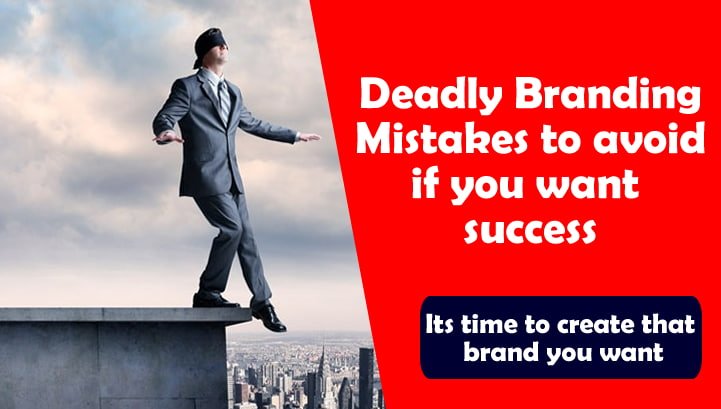The brand building process can be daunting. The payoff is huge and the costs are significant, so the stakes are high. That’s all the more reason to avoid costly blunders and mistakes while building your brand.
Here is our list of the most common mistakes made by firms trying to build a strong brand. You’ll notice that many of these mistakes occur early in the brand building process, well before you start brand promotion. A flawed foundation makes for a weak structure.
Avoiding these mistakes will help you build a brand that will attract your target audience and stand the test of time.

11 Branding Mistakes to Avoid in Business
No differentiators
If there is no difference between what you say about your firm and what competitors say about their firms, you have a weak brand. Unfortunately, this can have a negative impact on your firm’s growth and profitability. High-growth firms are 3X more likely to have a strong, easy-to-understand differentiator.
Here is a quick test to see if you have a true differentiator. Think of some way you believe your firm is different. Then ask if a potential competitor could ever say the opposite. If the answer is “no,” it is probably not a good differentiator. By the way, having great people and offering great client service don’t pass this test.
Trying to be everything to everyone
This typically results in being nothing special to anyone. Many firms head in this direction because they believe that offering more services creates more opportunities. In fact, they are making it much more difficult to attract new business. Having a clear focus or specialization is another attribute of high-growth firms.
Learn how to build a brand the right way— Register for practical hands on branding training
Not Having Brand Guidelines, lacking consistency
It is clear that organizations with consistent branding will always experience three to four times better visibility than those that are inconsistent. Brand inconsistency creates confusion in the market.
A company that lacks brand guidelines is bound to appear inconsistent. In turn, this presents your company as unprofessional and untrustworthy. So if you don’t have brand guidelines, make sure to develop them immediately. Make sure to cover the following areas:
How, when, and where to use the logo
Tone, voice, and writing style
Color schemes
Visuals and imagery
Fonts and typography
Brand guidelines make it easier for you to coordinate your content assets across every platform your company is represented, such as your website, social media pages, ads, and more. With a style guide, you can guarantee that your messaging is cohesive and consistent across all channels and communications. It also allows you to reinforce your brand identity and credibility.
Underestimating the Importance of a Logo
The logo is the face of the company. It’s the most recognizable feature of your brand. If you don’t do it properly in the beginning, changing it in the future may become a problem, especially when you haven’t fully established your presence in the market yet.
It’s also important to stick to a logo when your brand has already laid down its roots. In 2010, American clothing retailer giant Gap committed this mistake when they launched their newly designed logo, which received backlash. As the saying goes, “why fix something that isn’t broken?”
Understand that a great logo is immediately recognizable but creates a lasting impression. It’s synonymous with the brand itself and a glimpse of the brand’s identity.
Not realizing that your brand is your most important asset
With a strong brand (great reputation for expertise and high visibility in your target audience), a firm can replace people, modify service offerings or even change client segments with the full expectation that they can continue to enjoy success. The firm can be bought and sold on the strength of its brand in the marketplace. A professional and well-known brand can be a tremendously valuable asset and should be treated as such. Failing to understand and invest in your brand is shortsighted and costly in the long run.
Branding in a blindfold
Let’s face it, we all think we understand our clients and competitors. But we’re usually wrong — dangerously wrong. When we research most firms, we almost always find that internal staff and partners have a distorted view of what their clients really think. Firms that conduct systematic research on their target clients grow faster and are more profitable.
Making branding decisions a battleground for other issues
Sadly, many firms turn brand building into a battleground over the future of the firm. For instance, a simple logo decision can become a protracted battle over unresolved control issue. Brand development is difficult enough in its own right. Don’t burden it with unresolved issues around firm direction or control.
Aiming too low/ becoming Just another average brand
Good brands are both real and aspirational. They stand for something that people can get behind and support. Try to be a leader in something. Otherwise, you offer little reason for a prospect to choose your firm over another. Standing for something helps you build a strong brand.
Making a promise you can’t keep
The flip side of aiming too low is making a brand promise that you can’t keep. Overpromising will cost you credibility and trust. There is a fine line between being aspirational and being unrealistic. People will forgive you for aiming high and falling short of perfection — if you are still better than others. But if you aim high and deliver a mediocre product, don’t expect much understanding.
Forgetting digital branding
The world of business is changing. People are learning about your firm in ways they never did before. Don’t make the mistake of focusing on traditional approaches to branding while ignoring digital marketing’s growing role in brand building. The future of branding is digital, so plan for it in your strategy, brand building and rollout.
The “me-too” mistake
Fitting in with the rest of your competitors is not a sound strategy: “They use blue, I’ll use blue.” “Every government contractor uses pictures of a flag and a capitol dome, so I should too.”
While adopting attributes of your competitors may feel safer, it is actually playing with fire. It’s hard enough to tell most professional services firms apart. Don’t make it more difficult on your prospective clients. If you can’t be completely different, at least try to look and sound a different. It won’t hurt, and it will probably make your firm easier to recognize and remember.
A Final Thought
Building a strong brand centered on your firm’s expertise can have a profound impact on growth, profitability and overall firm value.
The key to success is to base your firm’s brand on a solid understanding of your marketplace, potential clients’ needs and exactly where your firm has an advantage. When you make that advantage widely visible great things start to happen.
If you don’t know how to go about building your brand, our brand development training is created to teach you how to build a brand that dominates the market and become successful.
Learn how to build a brand the right way— Register for practical hands on branding training
Frequently asked questions on branding
What mistakes do companies make branding in Nigeria?
While there are so many things that can go wrong while branding, One major mistake that small companies make concerning their brand is focusing on themselves instead of their customer. The best brands are customer-facing, not company-centric. Small companies can excel with their brand because they are often closer to the voice of the customer.
What makes a bad brand?
A “bad brand” is a brand that, for one reason or another, doesn’t resonate with audiences. The values may be weak or lacking, and the messaging may be all over the place. The design may be unappealing and not “make sense.” Good brands get their audiences to be passionate about it
What makes a good brand?
A good brand has a clear focus, knows their target audience, has a defined mission, knows their competition and USP, can identify their key values, tell their story and have a brand identity reflective of these goals, and does all of this consistently.






